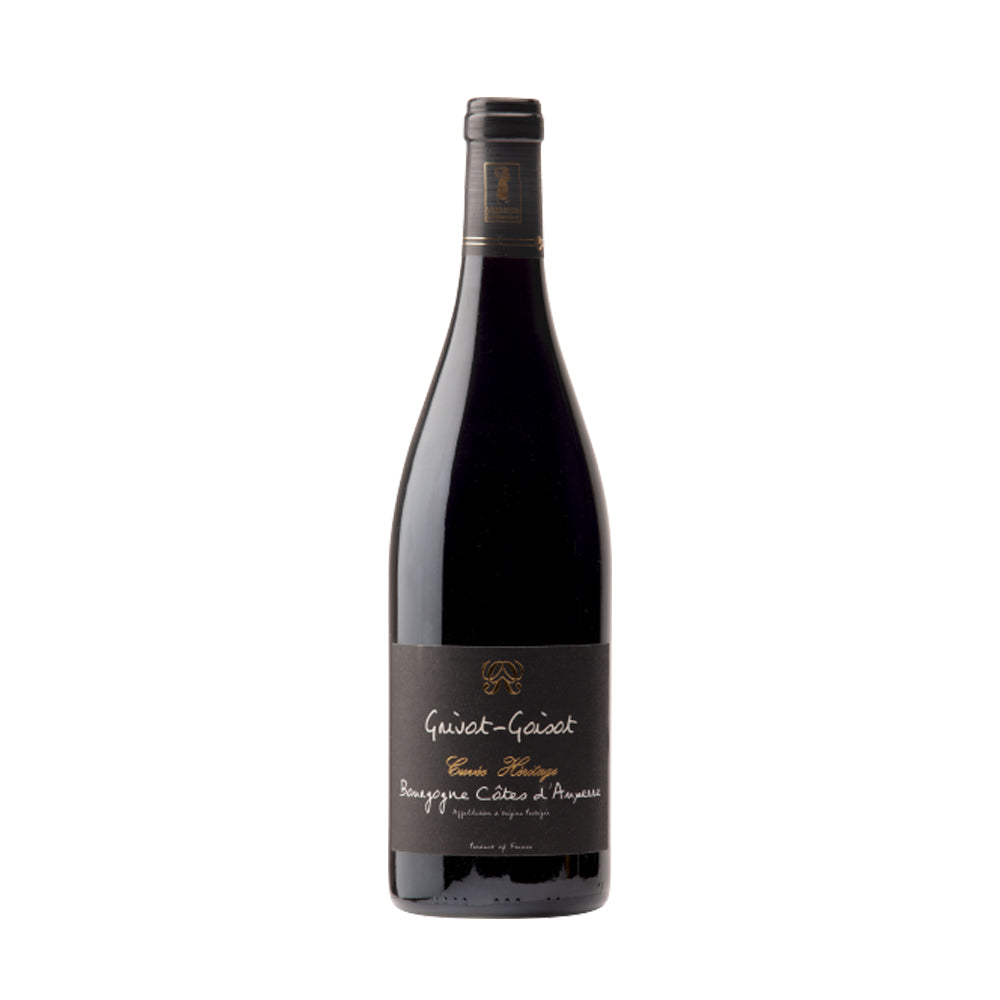
Mont Embrasé Cuvée Héritage Pinot Noir | Grivot-Goisot
NAME: Côtes d'Auxerre
TYPE: red
GRAPE VARIETY: 100% pinot noir
ORIGIN: France, Burgundy
EVOLUTION: 10 years
SERVING TEMPERATURE: 16-18° C
RECOMMENDED GLASS: large glass
ALCOHOL VOLUME: 13.5%
FORMAT: 75 cl
THE WINE:
TECHNICAL SPECIFICATIONS
FRESHNESS: ◼︎◼︎◼︎◼︎◻︎
BODY: ◼︎◼︎◼︎◻︎◻︎
FLAVOUR: ◼︎◼︎◼︎◻︎◻︎
SOFTNESS: ◼︎◼︎◼︎◼︎◻︎
TANNICITY: ◼︎◼︎◼︎◻︎◻︎
NOTES FROM OUR SOMMELIERS
👁 a beautiful purple red with purple reflections;
👃🏻 the nose is fruity, with red fruits in evidence, to which more complex toasted notes are added;
👄 The mouth is round and silky, characterized by fine tannins and dominated by red fruits, with a touch of wood; very elegant.
RECOMMENDED COMBINATION
An award-winning Pinot Noir, very elegant, perfect for accompanying game and other meats with complex cooking such as coq au vin - chicken marinated in wine - or beef bourguignon, another great classic of French cuisine.
REFINEMENT
One hectare vineyard, with 35-45 year old vines managed with simple Guyot pruning, with a density of 7,500 vines per hectare and vines with controlled grassing; green harvest, one month before complete maturation. Pure Pinot Noir harvested by hand; fermentation and aging in wood, for 12 months in French barriques, bottling at the estate.
YOU WILL LOVE IT FOR...
The finesse.
TERRITORY OF ORIGIN:
TERROR
We are in one of the most suitable areas in the world : Burgundy.
A unique and evocative territory, capable of producing extraordinary wines. The soil and climate conditions of Burgundy, combined with the special savoir-faire of the vignerons, due to centuries of quality agronomic practices, determine a unique terroir. The care and specificities in this region lead to the definition of climat, protected by UNESCO.
The Burgundy vineyards stretch for approximately 250 km between Chablis to the north and Mâconnais to the south, bordering the Rhône valley. The climate is predominantly continental, with light maritime influences in the western area up to Dijon and Mediterranean in the southernmost area. Winters are cold, frosts are quite frequent, sometimes even in spring; rainfall is minimal during the budding period but intense between May and June, and this can compromise flowering and therefore the harvest. The soil of Burgundy is made up of marine sedimentations mixed with limestone, marl and clay, with a prevalence of limestone in the Côte, from Dijon to Chagny. The territory is divided into these large sub-regions: the Auxerrois, the Chablis to the north in the Yonne, then the Côte-d'Or, the Chalonnais and the Mâconnais and the Beaujolais. In Chablis and Auxerrois, calcareous-marly soils prevail, in the Côte d'Or the soil richer in limestone allows Pinot Noir to express all its class, while in the southern area clay and marl give great elegance to Chardonnay. In Chalonnais and Chalonnais limestone, marl and clay reign, while in Beaujolais the soil is calcareous, shale and clay.
CELLAR
We are in Burgundy, in the heart of the Auxerrois vineyard, in a village called SAINT-BRIS-LE-VINEUX, where Sauvignon is also produced.
The Goisot family had owned vineyards since the 15th century, but it was in 1947 that Serge Goisot gave another dimension to the operation by launching into bottle production.
Since then the Domaine is the result of several generations of winemakers who remain faithful to the family traditions and the passion that animates them; Serge Goisot will give way in 1991 to Anne and Arnaud Goisot who in turn will pass on the exploitation and their knowledge to Anaëlle Goisot and René Grivot in 2020.
The Domaine cultivates 27 hectares and uses prestigious denominations such as Chablis, Chablis Premier Cru as well as Saint Bris, Bourgogne Côte d'Auxerre, and Bourgogne Aligoté.
Extremely attentive to quality, it leaves room for new winemaking technologies that bring a real advantage to exploitation and is in an environmental conservation approach. The Domain practices sustainable viticulture in a biodynamic regime , which is why they received the High Environmental Value Label (HVE) in 2020.
Theirs is a small and precious production of only 12,000 bottles a year.

When will I receive my order?
If the bottle is in stock it will be sent immediately and you will receive it in a couple of working days.
Is the order renewed?
No, this product is not bound by any type of subscription and cannot be renewed.
Is there a minimum number of bottles?
No, you do not have to order a minimum quantity of bottles: you can choose to receive just one bottle of each type.

This product has no reviews yet.
